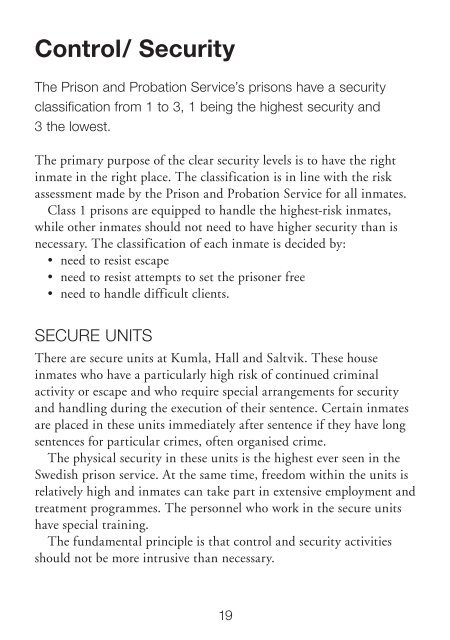SVAR DIREKT - Kriminalvården
SVAR DIREKT - Kriminalvården SVAR DIREKT - Kriminalvården
Control/ Security The Prison and Probation Service’s prisons have a security classification from 1 to 3, 1 being the highest security and 3 the lowest. The primary purpose of the clear security levels is to have the right inmate in the right place. The classification is in line with the risk assessment made by the Prison and Probation Service for all inmates. Class 1 prisons are equipped to handle the highest-risk inmates, while other inmates should not need to have higher security than is necessary. The classification of each inmate is decided by: • need to resist escape • need to resist attempts to set the prisoner free • need to handle difficult clients. SECURE UNITS There are secure units at Kumla, Hall and Saltvik. These house inmates who have a particularly high risk of continued criminal activity or escape and who require special arrangements for security and handling during the execution of their sentence. Certain inmates are placed in these units immediately after sentence if they have long sentences for particular crimes, often organised crime. The physical security in these units is the highest ever seen in the Swedish prison service. At the same time, freedom within the units is relatively high and inmates can take part in extensive employment and treatment programmes. The personnel who work in the secure units have special training. The fundamental principle is that control and security activities should not be more intrusive than necessary. 19
escapes/Absconding how many clients escape from Swedish prisons? In 2011, there were no escapes from the higher security prisons, while 24 persons absconded from low security institutions. The figures used to be higher, but have been steadily reduced in recent years. It is unusual for persons on remand in Sweden to abscond – none at all in recent years. 18
- Page 1 and 2: SVAR DIREKT om SVEn SK KRIm I n A l
- Page 3 and 4: Innehåll Vårt uppdrag ...........
- Page 5 and 6: Påföljder Vilka påföljder finns
- Page 7 and 8: Vad gäller för unga brottslingar?
- Page 9 and 10: Gäller samma regler för unga? En
- Page 11 and 12: Frivård Vilka är frivårdens uppg
- Page 13 and 14: KoNTRAKTSVåRD Vad innebär kontrak
- Page 15 and 16: Hur ser åldersfördelningen mellan
- Page 17 and 18: Särskilda utslussningsåtgärder S
- Page 19 and 20: Kontroll/säkerhet Kriminalvårdens
- Page 21 and 22: Finns det möjlighet att få behand
- Page 23 and 24: Vad är syftet med programmen? Utg
- Page 25 and 26: Personal Hur många arbetar i Krimi
- Page 30 and 31: The organisation of the Swedish Pri
- Page 32 and 33: Personnel how many people work for
- Page 34 and 35: what is the purpose of the programm
- Page 36 and 37: Is it possible to receive treatment
- Page 40 and 41: Specific release measures The purpo
- Page 42 and 43: what is the age distribution of pri
- Page 44 and 45: CONTRACT TREATMENT what does contra
- Page 46 and 47: non-custodial care what is the task
- Page 48 and 49: do the same rules apply to young pe
- Page 50 and 51: when can an offender be released? C
- Page 52 and 53: Sanctions what sanctions exist in S
- Page 54 and 55: Contents Our task .................
- Page 56: BASIC FACTS The SwedISh PrISon A n
Control/ Security<br />
The Prison and Probation Service’s prisons have a security<br />
classification from 1 to 3, 1 being the highest security and<br />
3 the lowest.<br />
The primary purpose of the clear security levels is to have the right<br />
inmate in the right place. The classification is in line with the risk<br />
assessment made by the Prison and Probation Service for all inmates.<br />
Class 1 prisons are equipped to handle the highest-risk inmates,<br />
while other inmates should not need to have higher security than is<br />
necessary. The classification of each inmate is decided by:<br />
• need to resist escape<br />
• need to resist attempts to set the prisoner free<br />
• need to handle difficult clients.<br />
SECURE UNITS<br />
There are secure units at Kumla, Hall and Saltvik. These house<br />
inmates who have a particularly high risk of continued criminal<br />
activity or escape and who require special arrangements for security<br />
and handling during the execution of their sentence. Certain inmates<br />
are placed in these units immediately after sentence if they have long<br />
sentences for particular crimes, often organised crime.<br />
The physical security in these units is the highest ever seen in the<br />
Swedish prison service. At the same time, freedom within the units is<br />
relatively high and inmates can take part in extensive employment and<br />
treatment programmes. The personnel who work in the secure units<br />
have special training.<br />
The fundamental principle is that control and security activities<br />
should not be more intrusive than necessary.<br />
19



